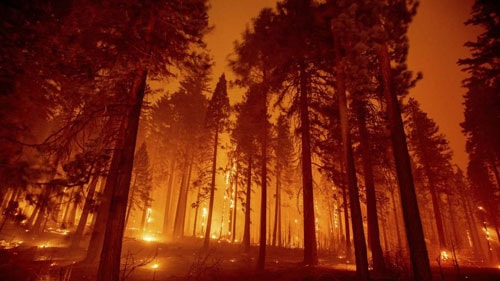California
An explosive California wildfire that has forced thousands of people to evacuate their homes and devastated a mountain community last week is “knocking on the door” of the Lake Tahoe basin, the state’s top fire official said Tuesday.
The Caldor Fire, which has burned more than 117,000 acres over 10 days and remains 9 percent contained as of Tuesday, forced the closure of schools in the Washoe County School District and several flights in and out of the Reno-Tahoe International Airport.
Intense smoke is also contributing to record-breaking hazardous air quality levels in the surrounding areas.
On Monday, the Washoe County Health District – Air Quality Management Division issued an emergency warning after the air quality index, or AQI, for the Reno-Sparks area hit 291, up from 251 the day before. Air quality is expected to be “very unhealthy” to “hazardous” through Wednesday.
Very Unhealthy to Hazardous air quality due to #CaldorFire smoke is continuing to impact Washoe County. #BeSmokeSmart everyone should be staying indoors and doing only light activity when inside.
Yesterday beat Sunday’s record for a 24-hr avg AQI. New record is 291 (was 251). pic.twitter.com/WXsJwXNIps
— Washoe County AQMD (@WashoeCountyAQ) August 24, 2021
On Monday, Thom Porter, director of the California Department of Forestry and Fire Protection, or Cal Fire, said the fire was the “No. 1 priority in the nation” for securing more resources to help stave off the damage it could inflict on the popular destination and region, which is home to tens of thousands of people.
“It is that important,” Porter told reporters, adding: “We have all efforts to keep it out of the basin.”
The blaze has destroyed 557 buildings, Cal Fire said. Last week, it incinerated much of Grizzly Flats, a small community 65 miles east of Sacramento.
Eric Schwab, a Cal Fire section chief, said Monday that limiting the fire’s eastern spread toward Tahoe and small mountain communities was a “huge priority.” But firefighters were struggling to contain a spot fire in that section of the blaze that was quickly expanding, he said.
More than 24,000 people remained under evacuation orders Monday in El Dorado County, where the fire ignited Aug. 14, according to the Governor’s Office of Emergency Management Services.
Evacuees have flooded camp sites, churches and shelters as they wait to return to their homes.
The blaze, which grew by more than 47,000 acres in less than 24 hours, jumped U.S. Route 50, the main thoroughfare through the Tahoe area.
The fire is one of 12 large blazes burning across the state. A Cal Fire spokesman said Monday that a staggering 1.5 million acres have burned in California this year, a 42 percent jump from last year, when the most acres in modern history burned across the state.
More than 14,000 firefighters are deployed across California as of Tuesday, according to Cal Fire.
Experts have attributed the state’s increasingly intense fire seasons to a historic drought magnified by climate change and a century of fire suppression policies that built up dense forests that can act as kindling.—AP










